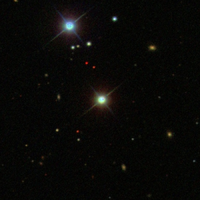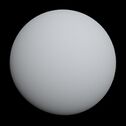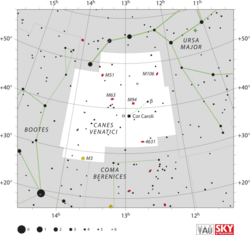Astronomy:Tuiren (star)
Location of Tuiren (circled) within Canes Venatici | |
| Observation data Equinox J2000.0]] (ICRS) | |
|---|---|
| Constellation | Canes Venatici |
| Right ascension | 12h 33m 03s[1] |
| Declination | +44° 54′ 55″ |
| Apparent magnitude (V) | 12.26 |
| Characteristics | |
| Spectral type | G |
| Astrometry | |
| Radial velocity (Rv) | -16.434 km/s |
| Proper motion (μ) | RA: -11.641 mas/yr Dec.: 8.065 mas/yr |
| Parallax (π) | 3.3678 ± 0.0258 mas |
| Distance | 968 ± 7 ly (297 ± 2 pc) |
| Details | |
| Mass | 1.022 ± 0.049 M☉ |
| Radius | 1.096 ± 0.056 R☉ |
| Temperature | 5580 ± 100.0 K |
| Metallicity [Fe/H] | 0.26 ± 0.08 dex |
| Age | 6.6 ± 1.8 Gyr |
| Other designations | |
| Database references | |
| SIMBAD | data |
Tuiren,[2] also referred to as HAT-P-36, is a 12th magnitude G-type main-sequence star estimated to be approximately 1,034 light-years away from Earth in the constellation Canes Venatici. Tuiren is too faint to be seen with the naked eye, but it is possible to view it with binoculars or a small telescope. In 2012 a hot Jupiter-type exoplanet was discovered orbiting Tuiren with an orbital period of about 1.3 Earth days.[3] In December 2019, HAT-P-36 was named Tuiren and its planetary companion, HAT-P-36b, was named Bran as a result of Ireland's contribution to the 2019 NameExoWorlds campaign.[4] Bran has a mass approximately 1.8 times that of Jupiter and a radius 1.2 times larger.
Etymology

Tuiren and its planet are named after characters from The Birth of Bran, a story in the book Irish Fairy Tales by James Stephens. The book is a re-telling of various stories from Irish folklore. Tuiren was the aunt of the mythical hero Fionn mac Cumhaill and was turned into a hound by the fairy Uchtdealbh after Tuiren married her husband. Bran and Sceólan were the two puppies mothered by Tuiren while she was a dog. They were cousins of Fionn mac Cumhaill. The names were proposed by John Murphy, a teacher at Regina Mundi College, Cork.[6]
Planets
| Companion (in order from star) |
Mass | Semimajor axis (AU) |
Orbital period (days) |
Eccentricity | Inclination | Radius |
|---|---|---|---|---|---|---|
| Bran | ≥1.832±0.099 MJ | 0.0238±0.0004 | 1.327347±0.000003 | 0.063±0.032 | 86±1.3° | 1.264±0.071 RJ |
Bran (HAT-P-36b) was discovered in 2012 by the HATNet Project using the transit method.[3] A search for transit timing variation did not result in detection of additional planets in the system as at 2021.[7] Surprisingly, a planetary orbital period increase by 0.014 seconds per year was detected by 2021.[8]
| Jupiter | Bran |
|---|---|

|

|
References
- ↑ 1.0 1.1 "Planet HAT-P-36 b". http://exoplanet.eu/catalog/HAT-P-36_b/. Retrieved 24 July 2020.
- ↑ "IAU100 NameExoWorlds Approved Names". International Astronomical Union. https://0bf71ea7-eb0b-44fe-ba3a-7895e80dc750.filesusr.com/ugd/6358ac_5eebee4eba4f41b7a9f6201123673a24.pdf. Retrieved 24 July 2020.
- ↑ 3.0 3.1 "HAT-P-36". http://www.openexoplanetcatalogue.com/planet/HAT-P-36%20b/. Retrieved 24 July 2020.
- ↑ Smith, Niall (29 September 2019). "Sky Matters: Ireland has the chance to name a star and a planet - any ideas?". Irish Examiner. https://www.irishexaminer.com/lifestyle/arid-30953790.html. Retrieved 24 July 2020.
- ↑ "TYC 3020-2195-1". SIMBAD. http://simbad.u-strasbg.fr/simbad/sim-id?Ident=TYC+3020-2195-1. Retrieved 24 July 2020.
- ↑ Gorey, Colm (18 December 2019). "Cork teacher names exoplanet and star after Irish mythical dogs". Silicon Republic. https://www.siliconrepublic.com/innovation/cork-teacher-exoplanet-star-irish-mythical-dogs. Retrieved 24 July 2020.
- ↑ Probing Transit Timing Variations of Three Hot-Jupiters: HATP-36b, HATP-56b, and WASP-52b, 2021
- ↑ Analysis of The Most Precise Light Curves of HAT-P-36 Detrended From Spot Signals, 2021


